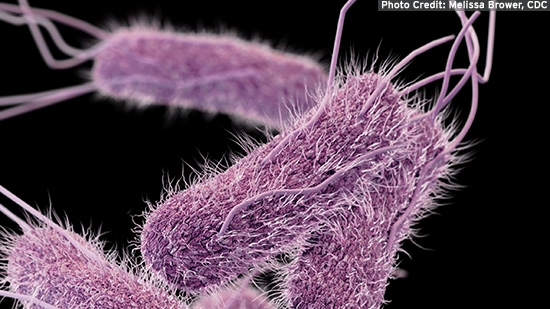
Salmonella
Download Salmonella Readiness Kits
Salmonella Fact Sheet and Response Tips
Salmonella Fact Sheet for Restaurants
WHAT IS SALMONELLA?
Salmonella are a group of bacteria that can cause diarrheal illness in people. This constitutes a major public health burden and represents a significant cost to society in many countries. One species, Salmonella enterica has more than 2,000 serovars. Salmonella enterica ser.Typhimurium and Salmonella Enteritidis most commonly encountered globally. Salmonella are inhabitants of the feces of many types of animals. According to a Centres for Disease Control and Prevention estimate, 1.0 million cases of foodborne salmonellosis occur each year in the United States.1 Salm-Surv is a global effort devoted to foodborne disease surveillance and outbreak detection; Salmonella is its original focus because of the significant role this organism plays in foodborne disease worldwide.2
WHAT ARE THE SYMPTOMS?
The disease caused by Salmonella is generally called salmonellosis. Symptoms of salmonellosis typically appear 12 to 96 hours after contaminated food is eaten, and last for one to four days. Symptoms include diarrhea, abdominal pain, chills, fever, vomiting, dehydration and headache. In some cases, individuals recovering from salmonellosis may continue to shed Salmonella in their feces for weeks to months after symptoms have disappeared.
HOW IS IT TRANSMITTED?
The primary reservoirs of Salmonella are the intestinal tracts of infected domestic and wild animals, thus foods of animal origin such as poultry, eggs, beef and pork are often sources. People can also carry Salmonella in their intestinal tracts. Salmonella is passed in the feces and can remain alive outside of the host animal for possibly years. Many foods, including produce, can become contaminated by the unclean hands of a food handler, by cross-contamination during preparation, or by irrigation or preparation of foods with contaminated water. Contaminated ice has also caused salmonellosis outbreaks. Other foods identified as vehicles for Salmonella transmission include coconut, chocolate, peanut butter, yeast, and soy. Flour may be contaminated with Salmonella; however, proper cooking inactivates the organism.
Outbreaks have occurred from foods contaminated with just a few cells, especially when the cells are protected in the digestive tract by high levels of fat in the food. Other foods involved in outbreaks may require higher contamination rates to result in illness. The infectious dose depends on the age and health of the host, strain differences among the members of the genus, and protective effects of the food.
A large Salmonella outbreak occurred in 2008 which affected 1442 patients, was epidemiologically associated with raw produce including tomatoes and Serrano and jalapeno peppers. Traceback connected this outbreak to a distributor and 2 farms. The contamination mechanism was not determined.3
The largest shell egg recall in US history occurred in 2010, when shell eggs from 2 production facilities were linked epidemiologically to more than 1470 cases of Salmonella Enteritidis (SE) illness. Environmental samples at the producers tested positive indicating that feed might be a source.4 SE can be found inside an infected egg, thus washing eggs will not eliminate the hazard.
HOW IS IT CONTROLLED?
Control of Salmonella focuses on adequate cooking of potentially contaminated foods. Cross-contamination control is also essential for cooked and ready-to-eat foods. Sanitary practices and adequate hand washing are critical in this area. Good Agricultural Practices are also essential for produce safety. The organism can grow over a temperature range of 7-46°C, water activity as low as 0.94, and pH from 4.4-9.4.5
In conjunction with the SE outbreak in shell eggs, the CDC issued recommendations6for handling eggs that included refrigerating eggs at ≤ 45°F, cooking until the white and yolk are firm, promptly refrigerating cooked eggs, performing proper sanitation of hands, utensils and food preparation surfaces, not consuming raw eggs and using pasteurized eggs where possible. Additionally, as part of a cooperative venture between the FDA and USDA, an egg safety rule7 was issued on July 9, 2010, which includes flock-based control programmes and routine microbiological testing. Education efforts on the requirements continue.
For assistance with this topic or other food safety questions for your operation, please Contact Us.
REFERENCES AND FURTHER INFORMATION
1Scallan E, Hoekstra RM, Angulo FJ, Tauxe RV, Widdowson M-A, Roy SL, et al. Foodborne illness acquired in the United States—major pathogens. Emerg Infect Dis. 2011 Jan. https://wwwnc.cdc.gov/eid/article/17/1/p1-1101_article.htm
2World Health Organisation Global Salm-Surv Progress Report 2000-2005. (1.84 MB)
3Salmonella outbreak attributed to multiple raw produce items, https://www.cdc.gov/mmwr/preview/mmwrhtml/mm5734a1.htm?s_cid=mm5734a1_e
4Multistate Outbreak of Salmonella Enteritidis Associated with Shell Eggs. https://www.cdc.gov/salmonella/enteritidis/
5International Commission on Microbiological Specifications of Foods. Microorganisms in Foods 5, Microbiological Specifications of Food Pathogens. Blackie Academic and Professional, New York. 1996.
6Egg safety information for consumers: https://www.fda.gov/Food/ResourcesForYou/Consumers/ucm077342.htm
7Egg Safety Final Rule


